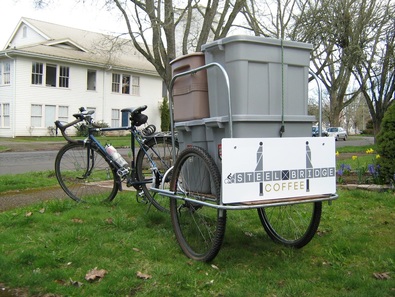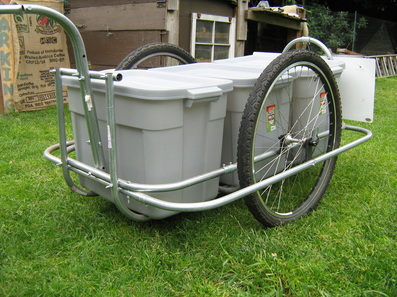|
This winter I set off to design and build a trailer for carrying goods to the Saturday Market to replace and improve on the trailer I used last year. I had the following goals: -increase total weight capacity -lower the center of gravity -improve the hitch system -make it compatible with Rubbermaid's 18 gallon bins Here is a picture of the old trailer... The load sits uneasily high and it hauls a maximum of four totes. I decided that I could improve the weight distribution by allowing space for three bins on the trailer bed. If I was hauling the same four bins only one would be on top and the center of gravity would be lowered. This makes for a bed length of four feet. The trailer is made from 3/4" EMT conduit (the old one used 1/2" conduit). In order to lower the center of gravity further, I formed bended lengths of conduit to bolt to the main frame of the trailer and dip down below the wheel hubs to form the bed. The bed consists of two lengths of conduit running lengthwise (this is what the totes sit on) and two lengths of conduit as braces running width-wise between where the totes sit. Lowering the bed below the wheel hubs necessitates using a large wheel. Most bicycle trailers use 20" wheels or smaller. Mine is equipped with 26" wheels and could accommodate 700c wheels. Smaller wheels may be a bit stronger, however, when I consider the amount of weight and abuse that a pair of 26" mountain bike wheels are designed to endure, I have no trouble trusting them to haul loads of 200-300lbs on short trips around town. Additionally, larger wheels roll over bumps more gently, which is an important advantage. While it's tempting to think that using a smaller wheel would lower the center of gravity, the goal is to lower the center of gravity in relation to the wheel hubs. This is what makes for a more stable load less prone to tipping. Finally, I chose to run the tow bar up the center of the trailer and mount it to a ball-joint on my rack directly above my bikes rear wheel. Many trailer hitches attach to the rear triangle but this makes it more difficult to use with a kick-stand, which I consider indispensable. This center mounting design is relatively simple and is common on cargo trailers. My only concern was how it would affect the handling of the bike, especially when the bike wants to lean. After three weeks of practice I can say that leaning is not a good idea while carrying a heavy load. As you lean, the front of the trailer dips downward and applies more weight into the lean; my experience is that this forces me to steer dramatically in the direction of the lean before I can stabilize the bike (at high speeds this would surely be disastrous but at slow speeds it is merely comical). The video below demonstrates how the trailer responds to the leaning of the bike. To adjust one needs to take curves slowly and remain as upright as possible. The advantage on curves is that your turning radius will not be hindered by your tow bar contacting your rear wheel. I've been loading the trailer with 5-6 bins and biking 2.5 miles to get to the market. I don't have a good way of measuring the total weight. I believe it's between 200 and 250 lbs.
You can see the trailer for yourself at the Salem Saturday Market between 9am and 3pm. Our coffee booth is near the corner of Marion and Winter Streets. Cheers!
5 Comments
|
|





